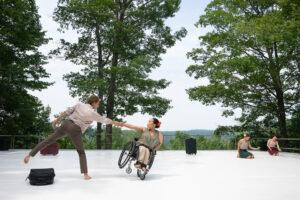
Nadia Adame is a Spanish multidisciplinary award-winning artist with a spinal cord injury. She studied Ballet & Flamenco at the Royal Dance Conservatory of Madrid and has a BA in Theatre from the University of Colorado. She was a company member with AXIS (2001-2003) and Candoco Dance Company (2007-2008). In 2004, she co-founded and was the Co-Artistic Director of Compañía Y in Spain, a multimedia and performance collective. Nadia’s credits include dance, theatre, commercial, and independent film projects in the UK, Spain, US and Canada.
What brought you back to AXIS after you left?
Well, Marc Brew, the Artistic Director of AXIS after Judith (Smith, director emerita), was leaving the company. I said ‘Oh, maybe I can apply for that job. I’ve had a lot of international experience both as a dancer, choreographer and director of my own company and AXIS for me feels like home’. It always felt like a place that I belong, where people understand disabled artists and value and celebrate them. And so for me, it was kind of a no-brainer to apply for the job. I did a proposal for the board of directors where I presented a project on how I planned to take AXIS forward. And I guess they liked it because I’m here, right?
What does your artistic community mean to you? What does it mean to create that artistic community and how does community play a role in your work?
One of the changes I made when I came into AXIS as Artistic Director has been to expand the understanding of disability and disabled artistry in the company. Traditionally, AXIS has been a physically integrated dance company – i.e open to both physically disabled and non-disabled dancers. I wanted to open that to the broader disability community. One of the things that I’ve done is that I have moved to open it to neurodiverse performers, artists, and community and also to people who are from the B/blind and D/deaf communities. For instance, this year we got our first mentor for our ChoreoLab choreographic development program who is visually impaired. At the end of the month of July, we’re going to have an apprentice who is hard of hearing.
I think it was wonderful that Judy started AXIS as a physically integrated company because that’s who she is. Now we’re opening the company up to a greater community.
One of the things I’m very conscious about is that as a disabled artist, I don’t always want to talk about disability. I want to do art, and sometimes it is a really difficult process.
I try something and it doesn’t work and I don’t like it and the audience doesn’t like it and sometimes I do things that artistically I really hate you know, but I always try to put the best production values into everything. Regardless of the piece itself, its themes or the way in which it is received, I want to create and curate diverse artistic work that represents the breadth and diversity of my community. I want them to see themselves represented on the stage and in the broader work we do, including our classes, workshops and training programs.
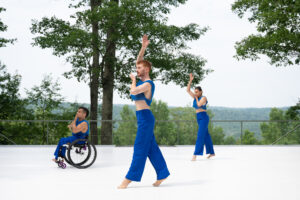
I would love to hear more about how you envision your role specifically as Artistic Director and how you bring your past experiences into that role.
Because I studied theater at the university level, I do a lot of work with the dancers so that they don’t only move from the neck down. Normally the thing that happens is that actors act with their face and dancers move from their neck down – I’m blending both worlds in a way. I worked a lot with the dancers and I brought a dramaturg to work with them and to think about their performance on the stage. I don’t only want to have dancers do whatever the choreographer says, I want to develop the dancers because I think the better they are, the better our company is. I want them to grow not only to do what the choreographers say, or what I say, I want them to grow as artists. I’m trying to give them a lot of opportunities to learn and prepare them for what is next for them. I also try to do a lot of work with the entire company on communication skills or more soft skills, the things that they’ll use their entire life. And yes, I want to open the company to the greater disability community, and include neurodivergent people and B/blind/low vision artists and collaborators and D/deaf collaborators. That’s what I’m trying to do moving forward.
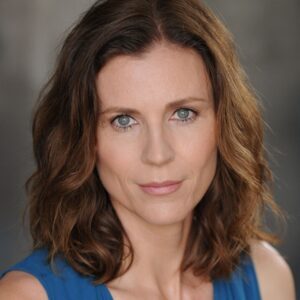
Can you tell us more about the program that you showed at Jacob’s Pillow?
The program we brought to Jacob’s Pillow is a lot about relationships. It’s a lot about how dancers relate to each other on the stage. In the first piece Flutter, there is no physical contact in between the dancers. It’s very pattern-like; the dancers move around a lot in repeated motifs, and they’re really aware of each other, like one. Robin Deckkers, the choreographer, said the dance is organized around “one move.” One dancer moves away from the space and the other dancer comes in and fills the space. The piece is really focused on these outward relationships.
Then the second piece, the one I choreographed, is called Historias Rotas. It’s definitely about our internal relationships to each other, but also, externally how we relate to our past and our ancestors. What themes do we carry and take with us in our journey? What are the things that we leave behind and what do we want to leave in the past? The piece asks: What are the things we take with us in our journey and what are the things we’re not taking, and it’s all represented in letters and suitcases the dancers carry.
The last piece Desiderata is by the Spanish choreographer Asun Noales, whose company I danced for when I was in Spain. It’s all about the desire of the skin and how the dancers relate to each other. For me, this program is a lot about relationships between the dancers, and also relationships to the audience. There are moments in which the dancers perform straight in front of the audience, and they just present themselves and they’re vulnerable and they are carrying all these relationships happening between them and between the audience. I think especially coming after the pandemic, relationships are incredibly important. I wanted to bring something that connects all of us, and I think this program speaks to that.
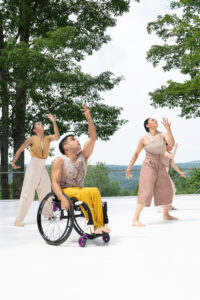
There are a lot of conversations about inaccessible institutions making accessible spaces, but many of these spaces still center non-disabled artists as the norm. What does a liberatory dance space look like to you and how does that vision influence your creation?
A liberatory space to me is a place where disabled people belong and they don’t have to ask for accommodations. My ideal space will be a place where the lighting is set up for people who are visually impaired and/or neurodivergent. There is closed captioning on a big screen. There are ramps obviously, not stairs. I want to make a place where all people belong. Of course, you cannot always make a space 100% accessible to everybody, because we’re all individuals and that also needs to be taken into account. We’re all unique and we all have our own story and experiences and that’s how we travel the world. But, a liberatory dance space tries to make it as accessible as possible for everyone.
Also, I think language is extremely important. I’ve worked with choreographers that will say, ‘run’. Well, I can’t really run. Instead, how do you say that in a different way where I feel included? You could just say, ‘move’ or ‘travel’ there. It doesn’t matter how I travel or how I move there, but if I do it with the same objective and the goal is the same, I’ll get there. Alternatively a lot of choreographers will stay ‘stand up’. If we have dancers who use a wheelchair, they can’t stand up. How do you say upright position or low position?
All of these things matter. I try to create art that tries to shift our collective understanding of language.
We’re also incorporating ASL and audio description in all of our shows. Depending on where we’re going and if it’s needed, we can also make a sensory friendly show where we bring different costumes so people can touch the texture of the materials we work with. We do an access tour right before the show in order for the dancers to describe themselves for people who are blind or have low vision or are visually impaired. We try to give all these options to everybody who comes to witness us perform. I’m doing a new piece in the fall in which I’m bringing in an audio describer who has been working with us for a long time– she was a dancer with AXIS too, and as such, she understands the language that we use. She’s going to audio describe the piece and then the (music) composer is going to take that audio description and embed it in the lyrics of the music.
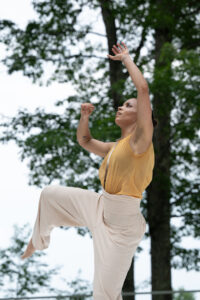
What are you most proud of in the work that AXIS is doing?
I think so far artistically, I’m very proud of the dancers. They have been able to take a lot of things on board, with many different people working with them, and they’ve been able to adapt to diverse artistic views really well. I’m very proud of them for that. As an entire company, I think we’ve been able to truly create an environment where people understand each other and where people can communicate with each other. When problems come up, people bring them up and we figure out a solution. I am not an Artistic Director who likes to make decisions by herself. I like to ask everybody their opinion. Of course, I make my decision at the end, I don’t leave it to them to make it because it is my role, and I need to do it. But I like to listen to all of their opinions and all of their concerns. Just last night we had dinner and I asked them a question about something that came up for one of our programs. We’ve been able to have that open communication, and I think it’s very important for any company to work in a healthy place. We’re very fortunate to be doing what we do and at the level that we’re doing it and we can’t take it for granted. We need to be a good team. I want to come to a place where I’m happy to go and work every day.
Anything else you want to speak about?
This is a very historical moment for the AXIS Dance Company. I know Judy Smith, the founding member/director of the company, has been working for this moment for a long time. I know Marc Brew and the previous directors have been working for this too. I think this is critical for us. We’re very, very honored to be here to share our work with the Jacob’s Pillow community. And it’s been wonderful working with the entire team and they’ve been asking a lot of questions about AXIS, and we’ve been learning from each other. I hope this relationship continues for a long time in the future.
For more about AXIS Dance Company, visit them at their website or follow them on Instagram @axisdanceco, or Facebook at AXIS Dance Company
This Pillow Pick was Edited by Tadea Martin-Gonzalez and published on July 26th, 2023.